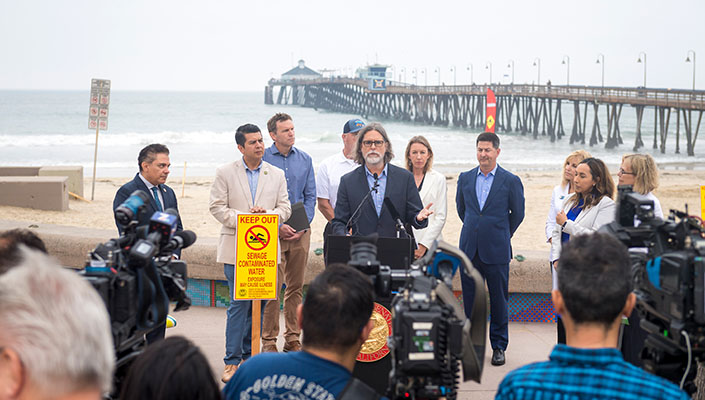UC San Diego’s Scripps Oceanography Awarded Funding to Develop Pathogen Forecast Model
Model aims to predict presence of harmful pathogens in Tijuana River Valley and Imperial Beach
Story by:
Published Date
Article Content
The state of California awarded UC San Diego’s Scripps Institution of Oceanography $3 million to develop a model to forecast the presence of pathogens in San Diego coastal and tidal waters. The funding was announced in a press conference on Aug. 25 alongside a bipartisan coalition of San Diego elected leaders at the Imperial Beach Pier.
The Tijuana River Estuary and Coastal Ocean Pathogen Forecast Model aims to predict the presence of bacterial and viral pathogens from untreated sewage in estuary and coastal waters, which can inform decision-makers when beach closures are necessary as the region works to address cross-border sewage pollution.
For more than 30 years, California’s southernmost coastline has been ravaged by discharges of trash, sediment and wastewater, including dangerous pathogens and chemicals flowing up from Mexico and through the Tijuana River. Since 1993, the City of San Diego has declared an ongoing state of emergency due to the serious public health risks that arise from untreated and partially-treated human and industrial waste flowing through our waters.
“This pollution has been poisoning our community for a generation,” said Senator Steve Padilla, whose 18th Senate District includes the communities of Chula Vista, the Coachella Valley, Imperial Beach, the Imperial Valley, National City, and San Diego. “As we work to stop this public health crisis at the source, this model will better inform decision-makers of when to close beaches, to keep beachgoers healthy while minimizing the impact to local businesses. The expertise that Scripps brings as the world’s premier oceanographic research institution is invaluable and their partnership means fewer beach closures and fewer illnesses.”
In April, Senator Padilla, joined by a bipartisan coalition of state legislators in the San Diego delegation, submitted a letter to the Chairs of the Senate and Assembly Budget Committees, requesting $3 million in the state’s budget to be allocated for Scripps to create and administer the forecast model. The request passed through several rounds of budget negotiations and was ultimately adopted with the passage of the state budget in June.
"For years, Scripps Institution of Oceanography has been working on developing science-based solutions to help protect residents, visitors, and businesses impacted by the cross-border pollution crisis,” said Margaret Leinen, UC San Diego’s vice chancellor for marine sciences and director of Scripps. “This model will provide the much needed real-time predictions to help keep beachgoers and community members safe and will also provide critical scientific monitoring needed to help validate proposed water quality infrastructure solutions."

The project will involve an interdisciplinary team of biological and physical oceanographers working together to develop the estuary and coastal ocean pathogen forecast model. Scientists at Scripps have already developed a physical model showing how ocean and estuary currents and contaminated wastewater are transported along the coast. This three-year program aims to expand to include pathogen modeling, data assimilation and forecast capabilities in real-time.
The program will also fund regular and event-based water sampling at beach and coastal locations to pinpoint the types of pathogens in the water and their abundances. Additional laboratory experiments will quantify the lifetime and decay of key microbial and viral pathogens in seawater under a range of conditions.
“I’ve been studying pollution transport in the border ocean region for 15 years and seen and experienced the impacts of untreated sewage in the ocean firsthand,” said Falk Feddersen, a physical oceanographer at Scripps. “We are very excited to develop this pathogen forecast model that will provide information to residents and tourists and reduce human health risk on both sides of the border.”
Furthermore, the model will enable effective decision making and project implementation for proposed cross-border water quality infrastructure solutions. Modeling results will be used to directly support and inform capital project planning, implementation, and monitoring. This robust modeling effort will help determine the net benefit and effectiveness of proposed capital projects.
Once developed, the forecasts will be directly accessible to the public and decision-makers on the Southern California Coastal Ocean Observing System website. Additional Scripps Oceanography scientists involved in developing the forecast model include Clarissa Anderson, Andrew Barton, Jeff Bowman, Bruce Cornuelle, Sarah Giddings and Uwe Send.
More information on past and present research underway in the Tijuana River Valley cross-border region can be found here in English and Spanish.
Share This:
You May Also Like
UC San Diego is Strengthening U.S. Semiconductor Innovation and Workforce Development
Technology & EngineeringStay in the Know
Keep up with all the latest from UC San Diego. Subscribe to the newsletter today.




